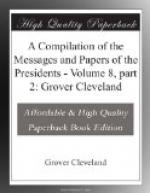The whole executive power being vested in the President, who is responsible for its exercise, it is a necessary consequence that he should have a right to employ agents of his own choice to aid him in the performance of his duties, and to discharge them when he is no longer willing to be responsible for their acts. In strict accordance with this principle, the power of removal, which, like that of appointment, is an original executive power, is left unchecked by the Constitution in relation to all executive officers, for whose conduct the President is responsible, while it is taken from him in relation to judicial officers, for whose acts he is not responsible. In the Government from which many of the fundamental principles of our system are derived the head of the executive department originally had power to appoint and remove at will all officers, executive and judicial. It was to take the judges out of this general power of removal, and thus make them independent of the Executive, that the tenure of their offices was changed to good behavior. Nor is it conceivable why they are placed in our Constitution upon a tenure different from that of all other officers appointed by the Executive unless it be for the same purpose.
But if there were any just ground for doubt on the face of the Constitution whether all executive officers are removable at the will of the President, it is obviated by the cotemporaneous construction of the instrument and the uniform practice under it.
The power of removal was a topic of solemn debate in the Congress of 1789 while organizing the administrative departments of the Government, and it was finally decided that the President derived from the Constitution the power of removal so far as it regards that department for whose acts he is responsible. Although the debate covered the whole ground, embracing the Treasury as well as all the other Executive Departments, it arose on a motion to strike out of the bill to establish a Department of Foreign Affairs, since called the Department of State, a clause declaring the Secretary “to be removable from office by the President of the United States.” After that motion had been decided in the negative it was perceived that these words did not convey the sense of the House of Representatives in relation to the true source of the power of removal. With the avowed object of preventing any future inference that this power was exercised by the President in virtue of a grant from Congress, when in fact that body considered it as derived from the Constitution, the words which had been the subject of debate were struck out, and in lieu thereof a clause was inserted in a provision concerning the chief clerk of the Department, which declared that “whenever the said principal officer shall be removed from office by the President of the United States, or in any other case of vacancy,” the chief clerk should during such vacancy have charge of the papers of the office. This change having been made for the express purpose of declaring the sense of Congress that the President derived the power of removal from the Constitution, the act as it passed has always been considered as a full expression of the sense of the legislature on this important part of the American Constitution.




